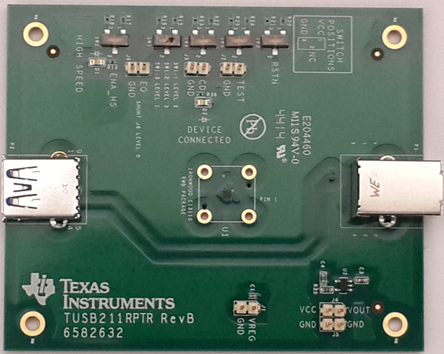-
TUSB211RPTR Evaluation Module
TUSB211RPTR Evaluation Module
Abstract
The TUSB211A is a High-Speed signal conditioner designed to compensate for ISI signal loss in a transmission channel. The TUSB211RPTREVM is designed to provide a simple means of demonstrating the signal conditioning capability of the TUSB211A. The EVM is preconfigured and simply connects the Type B connector on the EVM to the Type A receptacle found on a Host PC with a standard USB cable, a USB device plugs into the Type A receptacle of the EVM board. The TUSB211RPTREVM requires no external power as the EVM is powered from a VBUS, sourced from the Host port. Two LEDs indicate when a device is connected as well as when a high-speed connection is made and the TUSB211A is enabled.
 Figure 1-1 TUSB211RPTREVM Top View
Figure 1-1 TUSB211RPTREVM Top ViewTrademarks
All trademarks are the property of their respective owners.
1 Configuration Switches
The TI TUSB211RPTREVM has five sets of switches to facilitate configuration changes. Changing these switch settings without a complete understanding of the result is not recommended. Configuration inputs are only read by the TUSB211A during power on reset or after de-asserting the RSTN pin, changing these switch settings while the EVM is powered on has no effect. Refer to the device data sheet (SLLSEM5) for detailed pin descriptions and functionality along with the EVM schematic for additional information.
The switch definitions are as follows:
SW1 EQ (USB High-Speed (HS) Boost)
1 – Level 2 EQ
2 – Level 3 EQ
3 – Level 1 EQ*Note: Shunt J6 = Level 0
EQ
SW2 ENA_HS (High-Speed Mode Indicator)
1 – VCC
2 – NC (Default Controls LED HS Indication)
3 – GND
SW3 RSTN (Device Disable/Enable)
1 – VCC
(Device Enable)
2 – NC (Default)
3 – GND (Device Disabled)
SW4 CD (USB Device Attached Indicator)
1 – VCC
2 – NC (Default Controls LED Device Connected
Indication)
3 – GND
SW5 TEST (No Function Available)
1 – VCC
2 – NC (Default)
3 – GND